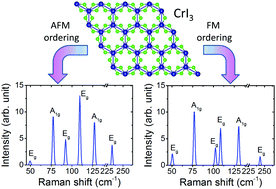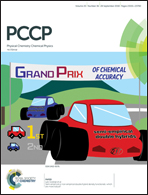Distinct spin–lattice and spin–phonon interactions in monolayer magnetic CrI3†
Abstract
We apply the density-functional theory to study various phases (including non-magnetic (NM), anti-ferromagnetic (AFM), and ferromagnetic (FM)) in monolayer magnetic chromium triiodide (CrI3), a recently fabricated 2D magnetic material. It is found that: (1) the introduction of magnetism in monolayer CrI3 gives rise to metal-to-semiconductor transition; (2) the electronic band topologies as well as the nature of direct and indirect band gaps in either AFM or FM phases exhibit delicate dependence on the magnetic ordering and spin–orbit coupling; and (3) the phonon modes involving Cr atoms are particularly sensitive to the magnetic ordering, highlighting distinct spin–lattice and spin–phonon coupling in this magnet. First-principles simulations of the Raman spectra demonstrate that both frequencies and intensities of the Raman peaks strongly depend on the magnetic ordering. The polarization dependent A1g modes at 77 cm−1 and 130 cm−1 along with the Eg mode at about 50 cm−1 in the FM phase may offer a useful fingerprint to characterize this material. Our results not only provide a detailed guiding map for experimental characterization of CrI3, but also reveal how the evolution of magnetism can be tracked by its lattice dynamics and Raman response.



 Please wait while we load your content...
Please wait while we load your content...